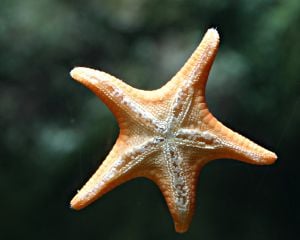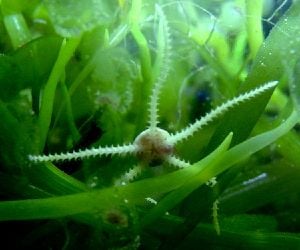| Echinoderms | ||||||||
|---|---|---|---|---|---|---|---|---|
 Sea urchin | ||||||||
| Scientific classification | ||||||||
| ||||||||
| Classes | ||||||||
|
Echinoderms (Phylum Echinodermata, from the Greek for spiny skin) are a phylum of marine invertebrates that are generally characterized by a hard, internal calcite skeleton (typically with spines), a water-vascular system, adhesive "tube feet," and five-rayed radial symmetry (at some point in their lives). This phylum includes the starfish, sand dollars, crinoids, sea urchins, sea cucumbers, and brittle stars.
Echinodermata is the largest animal phylum to lack any freshwater or terrestrial representatives. Representatives of the phylum can be found at all depths, from shallow, coastal waters to over 10,000 feet deep in ocean trenches (Towle 1989). They can be from 1 centimeter in diameter to one meter in diameter. Echinodermata traces to at least the early Cambrian period and contains about 7,000 known living species and 13,000 extinct ones.
Echinoderms offer important benefits to human beings. Both sea urchins and sea cucumbers are a popular food commodity in some cultures and some varieties of sea cucumbers are considered to have medicinal properties. The sea urchin is a popular subject of embyological study. Aesthetically, the diversity and sometimes brilliant colors of echinoderms provide a source of wonder and joy to human beings.
Types of Echinoderms
Five or six classes of echinoderms (six counting Concentricycloidea) are alive today:
- Asteroidea (asteroids, starfish, or sea stars): About 1,500 species that capture prey for their own food.
- Concentricycloidea (sea daisies), notable for their unique water vascular system, come in two species, recently merged into Asteroidea.
- Crinoidea (crinoids, feather stars, or sea lilies): About 600 species that are sessile and suspension feeders.
- Echinoidea (echinoids, sea urchins, and sand dollars): Notable for their movable spines; about 1,000 species.
- Holothuroidea (sea cucumbers): Armless, elongated, generally soft-bodied (small exoskeleton) animals, resembling slugs (retaining partial bilateral symmetry as adults); about 1,000 species.
- Ophiuroidea (brittle stars and basket stars): The physically largest of echinoderms; about 1,500 species, the largest echinoderm class. Primarily bottom feeders, and have long, narrow arms that allow relatively fast movement.
Extinct forms known from fossils include blastoids, edrioasteroids, and several early Cambrian animals, such as Helicoplacus, carpoids, Homalozoa, and possibly machaerids.
Physiology
Echinoderms appeared to have evolved from animals with bilateral symmetry, but whose later forms were lopsided. They undergo metamorphosis from larva with bilateral symmetry to a bottom-dwelling adult with radial symmetry (Towle 1989). Echinoderms' larvae are ciliated free-swimming organisms that organize in a bilaterally symmetric fashion that makes them look like embryonic chordates. Later, the left side of the body grows at the expense of the right side, which is eventually absorbed. The left side then grows in a pentaradially symmetric fashion, in which the body is arranged in five parts around a central axis. All echinoderms exhibit fivefold radial symmetry, or multiples thereof, in portions of their body at some stage of life, even if they have secondary bilateral symmetry. The worm-like sea cucumbers retain partial bilateral symmetry into their adult form.
Echinoderms also have a mesodermal endoskeleton made of tiny calcified plates and spines, which forms a rigid support contained within tissues of the organism. Some groups have modified spines, called pedicellariae, that keep the animal free of debris. The spines from which echinodermata gets its name are actually part of this internal skeleton and are covered by epidermis (skin).
Echinoderms possess a hydraulic water vascular system, a network of fluid-filled canals that function in locomotion, feeding, and gas exchange. Echinoderms typically have hundreds of transparent, adhesive tube feet. These tube feet extend from the canals, and can be extended or retracted by means of water pressure from the water vascular system. The tube feet, or podia, are sucker-like and can be used for movement and to grip objects.
Echinoderms possess an open and reduced circulatory system, and have a complete digestive tube (tubular gut). They lack an excretory system.
Echinoderms have a simple radial nervous system that consists of a modified nerve net (interconnected neurons with no central organs) and nerve rings, with radiating nerves around the mouth extending into each arm. The branches of these nerves coordinate the movements of the animal. Echinoderms have no brain (or head), although some do have ganglia.
The sexes of echinoderms are usually separate. Sexual reproduction typically consists of releasing eggs and sperm into the water, with fertilization taking place externally.
Regeneration
Many echinoderms have remarkable powers of regeneration.
A starfish cut radially into a number of parts will, over the course of several months, regenerate into as many separate, viable starfish. A section as small as a single arm (with the commensurate central-body mass and neural tissue) will, under ideal circumstances, successfully regenerate in this way.
Brittle stars, which are so named because sections of the arms can easily break off, regenerate the missing arms.
Sea cucumbers when threatened can eviscerateâeject their internal organs through their anusâand later regenerate the lost parts.
Importance of echinoderms
Echinoderms are important economically, ecologically, scientifically, medicinally, and aesthetically.
Sea urchins are a food item for humans, which is consumed either raw or briefly cooked. Sea urchin "roe" isn't actually roe, but rather the organs that produce the roe (the gonads). Sea urchin roe is a popular food in Korean cuisine, and it is called "uni" in Japanese sushi cuisine. It is also a traditional food in Chile, where it is known as an "erizo," and highly appreciated in Spain. Apart from domestic consumption, Chile and a number of other countries export the sea urchin to Japan in order to meet its demand throughout the country.
Sea cucumber is considered a delicacy in Far East countries such as Malaysia, China, Japan, and Indonesia. It is highly valued for its supposed medicinal properties. In Japanese cuisine, Konowata is made of sea cucumber entrails which are extracted, salted, and cured.
The trade in sea cucumber, between Macassans seafarers and the aborigines of Arnhem Land, to supply the markets of Southern China is the first recorded example of trade between the inhabitants of the Australian continent and their Asian neighbors.
Ecologically, echinoderms play a key role in food webs. In the case of sea cucumbers, these are typically scavengers, feeding on debris in the benthic layer, and consuming plankton and other organic matter found in the sea. A variety of fish, most commonly pearl fishes, have evolved a symbiotic relationship (commensalism) with sea cucumbers in which the pearl fish will live in sea cucumber's cloaca, using it for protection from predation, a source of food (the nutrients passing in and out of the anus from the water), and to develop into their adult stage of life. In the case of starfish, their place in the food web also impacts the world economically, as they feed on oysters, clams, and other organisms that humans consume.
Scientifically, the sea urchin occupies a special place in biology due to its long-time use as a standard subject for studies in embryology.
Medicinally, some varieties of sea cucumber (known as gamat in Malaysia) are said to have excellent healing properties. There are pharmaceutical companies being built based on this gamat product. Extracts are prepared and made into oil, cream, or cosmetics. Some products are intended to be taken internally. Claims have been made that sea cucumber helps a wound heal more quickly and reduces scarring.
Aesthetically, the diverse forms of the echinoderms, and their sometimes brilliant coloring, is often a source of joy to humans observing them.
Classification
Echinoderms, like chordates, are deuterostomes and are therefore thought to be the most closely related of the major phyla to the chordates, being a sister group to chordates plus hemichordates. (Some believe that acorn worms are more closely related to echinoderms than chordates.) Because of a controversial interpretation of Homalozoa, a minority of classifiers place the echinoderms into the Chordata.
The following is a classification including extinct forms:
- Phylum Echinodermata
- Subphylum Homalozoa Gill & Caster, 1960
- Class Homostelea
- Class Homoiostelea
- Class Stylophora Gill & Caster, 1960
- Class Ctenocystoidea Robison & Sprinkle, 1969
- Subphylum Crinozoa
- Class Eocrinoidea Jaekel, 1899
- Class Paracrinoidea Regnéll, 1945
- Class Cystoidea von Buch, 1846
- Class Blastoidea
- Class Crinoidea
- Subphylum Asterozoa
- Class Ophiuroidea
- Class Asteroidea
- Subphylum Echinozoa
- Class Helicoplacoidea
- Class Edriosteroidea
- Class Ophiocistioidea
- Class Holothuroidea
- Class Echinoidea Leske, 1778
- Subphylum Homalozoa Gill & Caster, 1960
ReferencesISBN links support NWE through referral fees
- Hyman, L. H. 1955. The Invertebrates. Volume IV: Echinodermata. New York: McGraw-Hill.
- McEdward, L. R., and B.G. Miner. 2001. Larval and life cycle patterns in echinoderms. Canadian Journal of Zoology 79:1125-1170.
- Towle, A. 1989. Modern Biology. Austin, TX: Holt, Rinehart and Winston. ISBN0-03-013919-8
Credits
New World Encyclopedia writers and editors rewrote and completed the Wikipedia article in accordance with New World Encyclopedia standards. This article abides by terms of the Creative Commons CC-by-sa 3.0 License (CC-by-sa), which may be used and disseminated with proper attribution. Credit is due under the terms of this license that can reference both the New World Encyclopedia contributors and the selfless volunteer contributors of the Wikimedia Foundation. To cite this article click here for a list of acceptable citing formats.The history of earlier contributions by wikipedians is accessible to researchers here:
The history of this article since it was imported to New World Encyclopedia:
Note: Some restrictions may apply to use of individual images which are separately licensed.


